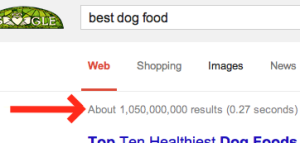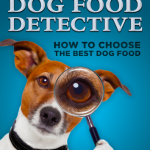There are many, many ways to choose the “best” dog food.

Just ask Google. And if you ask nicely, you’ll get over a billion answers. They can’t all be correct, can they?
Well, in some ways, perhaps they are. At least in part. But who has the time, or desire, to go through all these theories of what to look for, what to avoid, how to choose, or why This is better than That?
So relax.
Contrary to what you may have seen or read, it’s really not all that difficult to evaluate or choose a decent food. It can be as easy as one- two- three.
There are some excellent resources available to help with the process
You’ve most likely noticed there’s no shortage of information available claiming to be “the way” to find your answers. You can make it as complicated as you’d like. Or, you can choose a simple approach instead. Books, websites, handouts from the vet and even some manufacturer’s literature can all help make sense of the options.

Problem is, all of this information can become a bit overwhelming without a simple way to separate the good from the bad.
You may prefer to rely on the advice from a friend or pet shop employee. But read on if you’d like just a wee bit of reassurance that what you’re being told is based on facts.
Spotting some of the bad stuff is often pretty obvious, but what comes next?
Most of us know how to scan the Ingredient List. Nasty things like the preservatives BHA, BHT, artificial colors and flavors are easy to see. But some of the recognizable ingredients can often be trickier to understand than first meets the eye. This is where all the evaluation methods diverge in their approach.
Some methods use checklists, point or ratings systems. Others raise scary issues about what may be lurking inside a food bag. Still others have lists of formula names to seek out or avoid despite the constant state of change that pet foods go though.
With a little detective work of your own, you can easily find the the best food for your pet.
Simply start with your own preferences
Toss in a few facts, do some simple math and some decent choices will emerge. There’s no magic to it. And despite the constant changes in the pet food industry, this 3- step approach works quite well in almost every case.
Once you’ve identified some things that you may like or dislike, you’re on your way. For example, one of our clients wouldn’t think of feeding lamb to their dog. That’s a personal preference. It invokes memories of Bambi and that’s just not an option for the food bowl. Fine. No lamb- based foods in that house.
Perhaps you want a grain-free food because you’ve heard it’s “better.” Whether you choose to know why it’s better (or not) is entirely up to you. You’ve narrowed your options and can move on to the next step.
Next up is a quick look at ingredients, particularly the beginning the list
Some “experts” advise looking at just the first three ingredients, others say the first five, still other say anything listed before the Fat source. So who’s right? Everybody!

The big question is- what makes sense to you? I like to look at the first six ingredients, but sometimes stop after the first three. Other times I’ll read past six because it can become rather amusing.
Ingredient Lists can be rather creative things
At times, a single ingredient appears so many times in different forms that it invokes visions of what happens in the Large Hadron Collider.
Various forms of one ingredient can sometimes so overshadow a meat protein that it really doesn’t matter what type of preservative is used or whether there are any artificial flavorings or colors.
The point is- as long as you understand what you see, you’ll know when to stop looking. And once again, you can make this as simple, or as complicated, as you choose.
The more you know, the less likely you may want to continue feeding kibble. Dehydrated, raw or canned may become more attractive. On the other hand, a closer look may be reassuring to you. When your dog is doing well, you like what you see, there may be no compelling reason to question your choice.
Either way- you’re now ready to take that third step.
Now it’s time to consider the bottom line
The cost of a food is often the most difficult thing to understand. But it doesn’t have to be. Instead of pondering why there is such a wide range of prices, ask yourself a different question: what is the range of prices within the small group of foods that meet your preferences from the first two steps?
This can get fairly subjective, depending on what your earlier preferences turned out to be. If you’re not particularly fussy about your choices, you can easily choose a food that offers the best value. (We define value as the right combination of quality and price.) In some ways, the fussier you get, the easier it is becomes choose based on value. More limited options means fewer choices to compare.
It’s important not to just look at the price of the bag when considering value, especially when comparing different brands. The bag size and Feeding Guidelines play as much of a role in determining value as the bag cost. This is where a little detective work pays off.
If bag sizes are not identical, do a quick math exercise and figure out a price per pound. That tells you up front which bag really is cheaper to buy. It won’t, however, tell you which is cheaper to feed.
The only way to determine which will be less expensive to feed is to consult those Feeding Guidelines. And this final step is fairly simple as well: when you feed less of a food, the bag lasts longer. This is what tells you whether a cheaper bag of food will cost more to feed than a pricier choice. It’s all based on how much you use each day.
You can make choosing or evaluating a food simple or complicated
There are online resources that will go into far more detail about ingredients- what to look for, what to avoid, definitions, terms, science and scare tactics.
All you really need to know to get started are three simple steps. Take a moment to consider personal preferences, ingredients and the bottom line to gain the confidence you need to make your own informed choices.
And remember- if you don’t care to make your own pet food choices, there is no shortage of people willing to make them for you. Pick any of the billions of solutions offered by Google. They may, or may not, have your best interests at heart.
Choose wisely!


Always read the ingredients on your pet’s foods! I would say the ingredients are most important, then price. Great post, thanks for sharing!
Thanks, Elliot, glad you found it useful. Yes, ingredients are indeed most important. But if you can’t afford that wonderful food that beckons, price becomes the determining factor. Then it’s back the ingredients to find the best you can afford!
Your raw line looks great- congratulations on your contribution to the revolution!